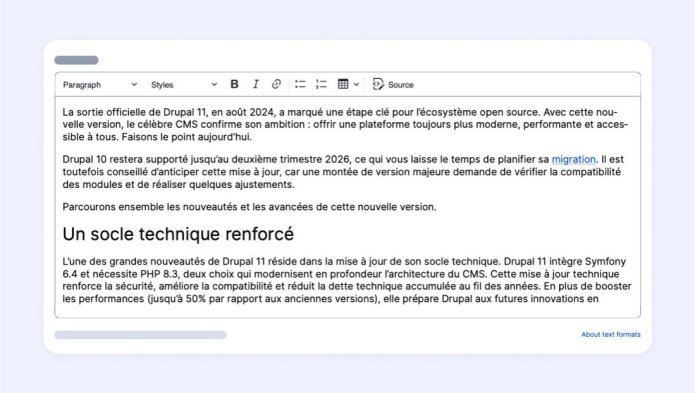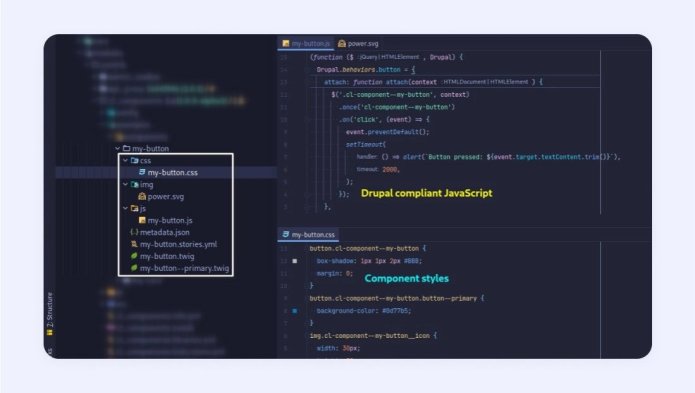The official release of Drupal 11 in August 2024 marked a key milestone for the open source ecosystem. With this new version, the famous CMS confirms its ambition: to offer an increasingly modern, high-performance platform that is accessible to all. Let's take a look at where we are today.
Drupal 10 will continue to be supported until the second quarter of 2026, giving you time to plan your migration. However, it is advisable to plan ahead for this update, as a major version upgrade requires checking module compatibility and making a few adjustments.
Let's take a look at the new features and enhancements in this new version.
A stronger technical foundation
One of the major new features of Drupal 11 is the update to its technical foundation. Drupal 11 integrates Symfony 6.4 and requires PHP 8.3, two choices that significantly modernize the CMS architecture. This technical update enhances security, improves compatibility, and reduces the technical debt accumulated over the years. In addition to boosting performance (up to 50% compared to previous versions), it prepares Drupal for future innovations in web development.
Drupal 11 also introduces a cleanup of the core system by removing certain deprecated modules, making the platform lighter and easier to maintain. Sites benefit from a smoother experience, even those with high traffic.
CKEditor 5: A modernized experience
With Drupal 11, the new CKEditor 5 text editor becomes the standard. More user-friendly and similar to a modern text software, CKEditor 5 helps you create and format content, while offering advanced features (collaboration, annotations, change tracking). Editorial teams benefit from increased efficiency and ease of use.
CKEditor 5 enhances the visual consistency of content and reduces errors during formatting, while also improving performance. This development puts Drupal on par with the best modern editing tools.

Improved accessibility and a newly designed interface
The Drupal community has also worked hard on accessibility (you can read our article on the new legislation here). Every user, regardless of their abilities, can now navigate and manage a website more easily. The new vertical navigation makes the administration interface more intuitive and refined, simplifying the learning curve for non-technical teams.
These improvements demonstrate Drupal's commitment to reaching a wider audience by focusing on user experience and ease of use without compromising on performance.
Game-changing modules
Drupal 11 builds on the philosophy introduced in Drupal 10 by integrating or stabilizing several innovative modules:
- Automatic Updates : This highly anticipated feature simplifies technical maintenance by allowing sites to update securely without constant manual intervention.
- Project Browser : A tool that facilitates the search and installation of modules from the administration interface, making Drupal more accessible even to less technical users.
- Workspaces : Now stabilized, it allows significant changes to be prepared in an isolated environment before being released into production.
- Single Directory Components (SDC) : A modernized approach for front-end developers, which groups all files related to a component (template, CSS, JS) into a single folder. This simplifies code maintenance and promotes reuse.
- Recipes : A system of ready-to-use configuration “recipes” that allow you to quickly install a set of modules and settings to meet a specific need (blog site, showcase, event portal, etc.).

Why upgrade to Drupal 11?
Upgrading to Drupal 11 offers many advantages:
- Enhanced security: by using the latest versions of PHP and Symfony, you protect your site against vulnerabilities.
- Improved performance: a noticeable gain in speed and efficiency, crucial for SEO and user experience.
- New features: tools that simplify daily management and accelerate development.
- Longevity: Drupal 10 will be supported until 2026, but anticipating the migration allows you to stay ahead of the curve and take advantage of upcoming improvements.
For sites running on Drupal 10, migration to Drupal 11 is a simple update, provided that the core is up to date (specifically Drupal 10.3). Sites still running on Drupal 9 will first need to migrate to Drupal 10 before upgrading to the latest version.
What comes after Drupal 11?
Since its release last year, minor versions of Drupal 11 (11.1, 11.2, etc.) have gradually introduced eagerly awaited features such as Experience Builder, a tool for complex layouts in visual mode. At the same time, the Project Browser and automatic updates have been improved to simplify the installation and maintenance of modules and the core.
The Drupal community, with thousands of contributors around the world, continues to work on initiatives to make the CMS simpler, more flexible, and more intuitive. The long-term goal is to further expand the user base while maintaining the power and modularity that have made Drupal so successful.
With Drupal 12 expected in mid-2026, the future looks set to be rich in innovation. This new version should take automation, the no-code/low-code experience, and advanced customization even further, consolidating Drupal as an essential solution for ambitious and scalable websites.
Conclusion
Drupal 11 marks a major step forward in the evolution of the CMS. By reinforcing its technical foundation, modernizing the editorial experience, and making the interface more inclusive, it has established itself as an essential tool for meeting today's digital challenges. This version combines performance, security, and simplicity, while paving the way for future innovations.
For companies, institutions, and organizations that want to stay ahead of the curve, Drupal 11 is a strategic choice that opens the door to more agile and forward-looking content management.



